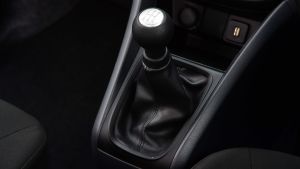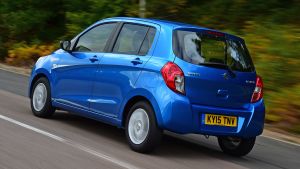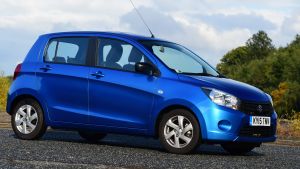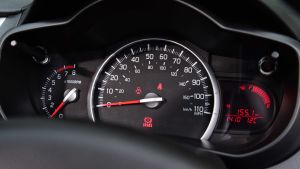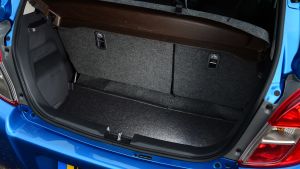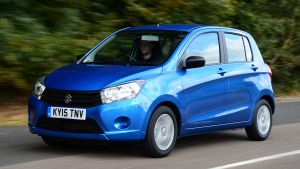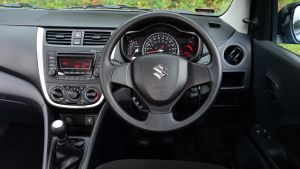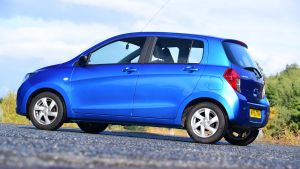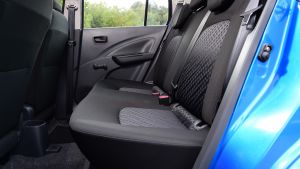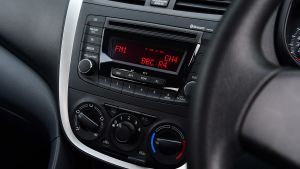Verdict
The Celerio might look rather comical with its wheels pushed right out to the corners and its high roofline, but there’s plenty to like about this cheeky city car. It feels like a bigger vehicle with its roomy cabin, but it doesn’t have the ambience of an up! or a Picanto, so it seems like a budget product, although the flip side is that the no-nonsense attitude is a welcome breath of fresh air. The Suzuki is small so it’s nippy and easy to park, while the steering and gearchange are slick, and the ride is tuned for comfort, so it’s an easy car to drive. Buy a top-spec Celerio and the kit levels are pretty good, although the infotainment is basic by modern standards. But if low purchase and running costs are key factors, the Suzuki is definitely worth a closer look.
Most Japanese brands started out by building tiny-engined cars before moving on to much bigger and more costly vehicles. It’s how Honda, Nissan, Toyota, Mazda and Subaru began, and Suzuki, too.
But whereas the first five went on to focus more on relatively costly family-sized models, Suzuki’s emphasis has long been on smaller vehicles created mainly for urban drivers. For decades the company has offered city cars and superminis, some better than others, and one of the more recent is the already-defunct Celerio, which arrived in 2014 and was killed off five years later.
Few people noticed its demise and it would be easy to dismiss this boxy small car as an also-ran, but the pint-sized Suzuki is actually rather endearing, for a multitude of reasons.
Models covered
- Suzuki Celerio (2015-2019) - No-nonsense city car offers cheap running costs and a surprising level of practicality.
History
The Celerio went on sale in February 2015, with the first cars being delivered soon after. Initially the range was limited; there was a 1.0-litre engine with a manual gearbox, and just two trim levels (SZ3 and SZ4), priced at £7,999 and £8,999 respectively.
Three months later two new versions joined the range. An AGS (Auto Gear Shift) automatic transmission was introduced in SZ4 form only, alongside a more efficient 1.0-litre Dualjet engine with stop/start, available only with SZ3 trim.
In July 2015, there was another addition to the range, the entry-level SZ2, which was priced at just £6,999 and available with a manual gearbox only. The final Celerio development was the introduction of the City special edition in August 2017, based on the SZ2 and limited to 500 units.
Which one should I buy?
At these prices, the obvious answer is the highest-spec car that you can find (an SZ4). The Celerio SZ2 came with a DAB radio, CD player, central locking, a 60:40-split folding rear seat and 14-inch steel wheels. Moving up to the SZ3 brought 14-inch alloys, remote central locking, air-con, Bluetooth and a USB port, while the range-topping Celerio SZ4 added electric rear windows, four speakers for the stereo, electric adjustment for the door mirrors and front foglights.
Unlike most of its rivals that offer extensive options lists, the Celerio could be specified only with an array of dealer/home-fit extras such as different wheels, mudflaps, bumper protectors and spoilers/side skirts. You can see the complete catalogue at www.suzuki.co.uk/cars/accessories.
Alternatives to the Suzuki Celerio
Older, more costly and more impressive for their big-car feel are the SEAT Mii, Skoda Citigo and Volkswagen up!, but they’re not nearly as roomy as the Celerio. If practicality is key, you need to look at the rear-engined Renault Twingo and Smart ForFour, which are essentially the same car; they’re cleverly designed and good fun to drive, but not common on the second-hand market.
The Kia Picanto and Hyundai i10 feel very grown up despite their titchy dimensions; they’re also great value and come with seven and five-year warranties respectively. The Toyota Aygo, Citroen C1 and Peugeot 108 are mechanically the same car and they’re all worth a look because they’re plentiful, good value and fun to drive. You should also consider the Vauxhall Viva, which is roomy as well as cheap to buy and run.
What to look for
Safety
Many of the Celerio’s rivals came with a four or five-star Euro NCAP safety rating; the Suzuki only got three stars when tested.
Driving position
The front seatbelts aren’t height-adjustable and the steering wheel alters for rake only, not reach, so check you can get comfy.
Puncture repair
The Celerio doesn’t come with a spare wheel of any kind, not even a space-saver. Instead there’s an emergency repair kit.
Towing
Somewhat surprisingly, this pint-sized Suzuki city car has been homologated for towing, but the most that you can pull is just 400kg.
Interior
There’s little to excite here, but the Celerio’s dash is well laid out, and the cabin is better than you might think in terms of quality, but it’s still plasticky. The most impressive thing about the interior is how much room it offers: plenty for four adults, or even five at a pinch. It’s not as though the boot is tiny to compensate; it’ll stow 254 litres with the rear seats up, which jumps to 835 litres if the rear backrests are folded. Beneath the centre console, there’s a USB socket and an area for storing your mobile phone. There are also a few pieces of silver plastic trim and brighter-coloured inserts to liven the cabin up a bit.
Prices
You find out prices for a used Suzuki Celerio on our sister site, BuyaCar.
Running costs
The Celerio needs to be serviced every 12 months or 12,500 miles, whichever comes first. Suzuki dealers have a price structure for the first 10 check-ups, which is published as £141 (first and seventh services), £265 (second and fourth), £182 (third and ninth), £190 (fifth), £340 (sixth), £405 (eighth) and £333 (10th).
However, this is largely redundant because once a Celerio reaches its third birthday, it’s eligible for fixed-price maintenance, with services alternating between minor and major, at £129 and £279 respectively. While a minor service is merely an oil change, the major check includes fresh brake and clutch fluid, plus new air and pollen filters. Also included in the price is 12 months’ roadside assistance. Because the Celerio’s engine is chain-driven there’s no cambelt to replace.
Recalls
Just two recalls have been issued for the Celerio so far, but the first one, embarrassingly, was implemented within days of the car going on sale, in February 2015.
The problem was rooted in the fact the brake pedal was designed to separate from the pedal box in an impact, to protect the driver’s foot. Unfortunately it turned out the pedal could separate simply as a result of heavy braking, leaving the car with no foot brake; a redesigned pedal box was the solution to this worrying defect. Despite this recall being issued so early in the Celerio’s life, 3,193 cars were still caught up in it.
The second action in May 2018 affected 698 cars built in January and February 2018. This time it was because the side airbags could fail to work correctly in a crash, due to a manufacturing fault with their retaining brackets.
Driver Power owner satisfaction
The Celerio is too niche a seller for it to have appeared in our new or used Driver Power surveys, yet a result of 17th out of 30 for Suzuki in this year’s brands ranking is reasonable; but last year it managed eighth. Three quarters of owners who left reviews on our sister website Carbuyer awarded the full five stars for the Celerio’s value, economy, reliability, roomy cabin plus its agility and, surprisingly, perky performance.
